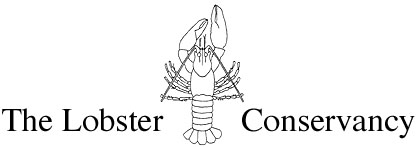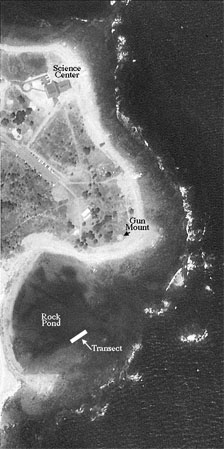
The Lobster Conservancy (TLC) is a non-profit organization dedicated to protecting and preserving the American lobster and the traditional trap fishery it supports through scientific research and public education. One of the main scientific and educational programs of TLC is the volunteer-based Intertidal Lobster Monitoring Program (Cowan 1999). The program began in Harpswell, Maine in 1995 and is being expanded throughout Maine and other parts of New England.
The primary objectives of Intertidal Lobster Monitoring Program are to identify and seek protection for coastal nursery habitats for juvenile lobsters by: (1) identifying the location and time of settlement of postlarval lobsters; (2) quantifying the abundance of juvenile lobsters inhabiting the intertidal zone; and (3) describing the basic ecology and behavior of early juvenile lobsters.
New Hampshire volunteers, Alan Stewart and Bobbi Costello, joined the program in 1998, by surveying the intertidal zone of Odiorne Point State Park, NH. This report summarizes the data they collected in 1998.
Methods:
The Intertidal Lobster Monitoring Program uses a standard ecological method of data collection called quadrat sampling. This involves setting up a 20-meter long transect line along the shoreline, then sampling along the transect line in steps, one square meter at a time. Each step is defined by placing a square quadrat alongside the transect, then describing the habitat and organisms found within that square. If time allows, random sampling beyond the transect is also encouraged. Volunteers monitor their sites at least once a month from May through October during the spring low tides. When a lobster is found, data is collected on the total number of lobsters found together, and on length, sex, handedness, number of claws, and any distinguishing characteristics such as injuries or coloration. All lobsters are returned to their shelters.
Results:
Data were collected at Odiorne Point State Park (Figure 1) on 14 days during the spring low tides, May through October (Table 1, Figure 2). Including data from quadrat sampling and random sampling, a total of 214 lobsters were found, ranging in size from 4-68 mm carapace length. The sex ratio was 2:1 males to females (n = 143 and 70 respectively; Figure 3). The incidence of injury is relatively low for intertidal lobsters as evidenced by most lobsters having both claws (Figure 4).
The density of lobsters was measured by quadrat sampling. Density increased from May through June, peaked in July, then fell off from August through October (Figure 4).
Table 1. Summary of intertidal surveys for juvenile lobsters, Odiorne Point State Park, NH, May-October 1998
| Month | Days surveyed | Number of lobsters | Minimum carapace length (mm) | Maximum carapace length (mm) | Mean carapace length (mm) | Std. Deviation |
| May | 2 | 8 | 25.0 | 48.0 | 31.9 | 7.9 |
| June | 4 | 41 | 23.0 | 48.0 | 35.6 | 5.9 |
| July | 3 | 93 | 20.0 | 68.0 | 34.8 | 7.7 |
| August | 2 | 57 | 4.0 | 55.0 | 33.3 | 7.8 |
| September | 1 | 9 | 25.0 | 45.0 | 32.3 | 7.2 |
| October | 1 | 6 | 26.0 | 39.0 | 33.2 | 5.3 |
| All | 13 | 214 | 4.0 | 68.0 | 34.3 | 7.4 |

Figure 1. Location of study transect at Odiorne Point State Park, New Hampshire.

Figure 2. Size-frequency distribution of juvenile lobsters, Odiorne Point State Park, NH, May-October 1998

Figure 3. Sex of intertidal juvenile lobsters, Odiorne Point State Park, NH, May-October 1998 (n = 214)

Figure 4. Number of claws possessed by intertidal juvenile lobsters, Odiorne Point State Park, NH, May-October 1998 (n = 214)

Figure 5. Density of lobsters per square meter, intertidal juvenile lobsters, Odiorne Point State Park, NH, May-October 1998 as measured by quadrat sampling (n = 38).
Discussion:
Odiorne Point State Park clearly provides an intertidal nursery ground for juvenile lobsters. During their surveys our observers noted several features that may have negative impacts on the nursery habitat within the park. These include poaching of sublegal lobsters by tourists and leakage of raw sewage into the study site. In addition, in certain areas lobsters were found dead in their borrows, although they exhibited no external wounds. The source of this mortality is as yet unknown.
We would like to continue to monitor this site to look for interannual trends in distribution and abundance. We would also like to search elsewhere along the coast of New Hampshire for additional nursery grounds.
The data collected in New Hampshire will ultimately be incorporated with all data collected by volunteers in the Intertidal Lobster Monitoring Program. This will allow comparison across a broader geographical range.
References:
Cowan, D.F. (1999) Method for assessing relative abundance, size-distribution, and growth of recently settled and early juvenile lobster (Homarus americanus) in the lower intertidal zone. Journal of Crustacean Biology, in press.